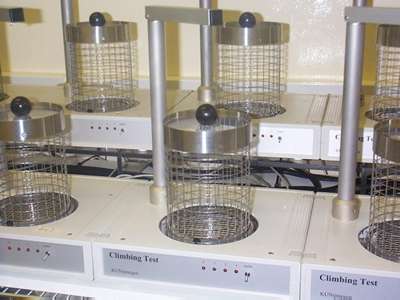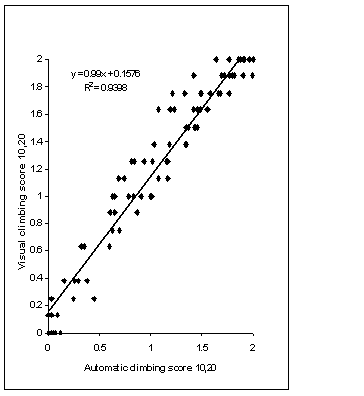
A novel automated apomorphine climbing test
W.H.I.M. Drinkenburg1, P. Vijn1, M.G. Martorana1, M. Dickson1 and W. van Schaijk2
1Organon
Laboratories Ltd., R & D, Newhouse, Lanarkshire, United Kingdom
2ERG, NICI, University of Nijmegen, Nijmegen, The Netherlands
Apomorphine-induced climbing behaviour in mice is used by the pharmaceutical industry for selecting compounds, which interact in vivo with dopaminergic neurotransmission [1,4,5]. Classically, climbing is determined visually using various climbing scores: climbing/not-climbing [6], duration of climbing [1], or rank scales [2,4]. These methods require a well-trained observer, while observational bias may result in differences between two experimenters. An automated scoring system would minimise differences and improve reproducibility and efficiency. The validation of a novel, automated climbing system that detects the climbing activity of mice by means of electrical conductivity and infrared beam breaks is presented.

Figure 1. The novel automated system as in use at Organon Newhouse, Scotland (built at ERG/MID departments, University of Nijmegen, The Netherlands
Test compound or vehicle is administered subcutaneously (SC) 30 minutes before apomorphine HCl (0.75 mg.kg-1, SC). Mice are then placed individually in metal mesh cylinders (diameter 12 cm, height 14 cm, Figure 1) where they stay for 30 minutes during which climbing behaviour is monitored. The system samples continuously and outputs the data as either climbing scores or duration of climbing. The climbing scores and ED50 values for inhibiting apomorphine-induced climbing for five psychoactive compounds (Table 1) produced by the automated climbing system were compared to those obtained by visual rank scoring [4].
Average climbing scores per animal were determined by three methods:
A climbing score is determined by averaging the individual scores in each treatment group and each run. Fifteen climbing scores are thus determined per experiment.
Table 1. ED50 values together with their 95% confidence limits for the inhibition of apomorphine-induced climbing by various psychoactive compounds.
| Coumpound | Visual 10, 20 | Automated 10, 20 | Automated 10-21 |
| Clozapine | 4.52 (3.19-6.40) | 4.06 (2.57-6.42) | 4.54 (2.87-7.19) |
| Diazepam | No Fit | No Fit | No Fit |
| Mirtazapine | 15.5 (8.8-27.4) | 15.4 (6.1-39.0) | 16.0 (5.3-48.3) |
| Chlorpromazine | 0.29 (0.19-0.45) | 0.30 (0.18-0.49) | 0.30 (0.19-0.47) |
| Haloperidol | 0.023 (0.016-0.033) | 0.017 (0.012-0.026) | 0.018 (0.013-0.023) |
For the coumpounds tested, 75 visual climbing scores were plotted against 75 automatic climbing scores, and a regression line was fitted. . Results obtained showed a good correlation between visual and automated climbing scores (r = 0.94, Figure 2) and calculated ED50'S (Table 1).

Figure 2. Plot and the linear regression between the automatic scores and the visual scores.
Automatically scoring climbing is not a new approach, a mechanical system using the force applied to a transducer by a mouse climbing a cage, was described as early as 1977 [3]. However, mechanical systems require calibration and are more prone to failure. Our automated climbing system not only correctly identified active test compounds, but also generated climbing scores and ED50 values similar to those obtained by visual scoring. This novel climbing system is an efficient and validated instrument for drug discovery and development.
Poster presented at Measuring Behavior 2000, 3rd International Conference on Methods and Techniques in Behavioral Research, 15-18 August 2000, Nijmegen, The Netherlands